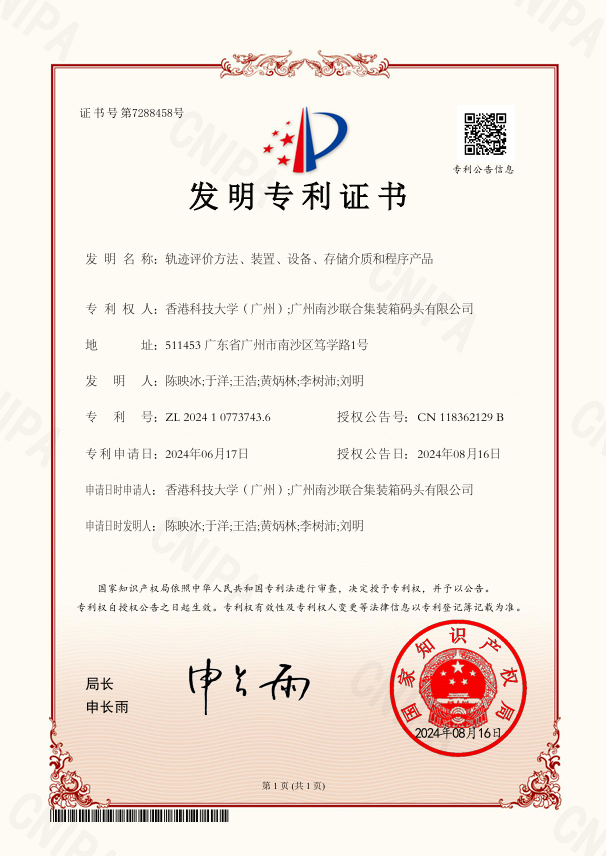Nansha Phase IV Obtains a National Invention Patent (Picture)

Recently, the “Trajectory Evaluation Methodology, Device, Equipment, Storage Medium and Program Product” declared by Guangzhou Port Nansha Phase IV has obtained the national invention patent certificate. With the patent acquired, the accuracy of driving trajectory evaluation of remotely piloted vehicle (RPV) can be further improved, and this has a popularization and application value in the fields of intelligent calculation and path selection of driving trajectory of RPV.
With the development of science and technology, driver-less technology has been widely applied in logistics parks, ports and wharves, online car-hailing industries and other fields. The active safety and intelligence of unmanned driving have also become hot issues at home and abroad.
Before RPV runs at the set driving trajectory, the trajectory generator will generate several alternative driving trajectories, and then evaluate them through the trajectory evaluation algorithm, and later automatically select one with the highest evaluation grate as the target trajectory of RPV. However, the existing alternative trajectory evaluation methods are relatively rough and cannot meet the needs of accurate and safe path selection in complex operation scenarios of ports and wharves.
To solve this problem, Nansha Phase IV has worked with the scientific research team of Hong Kong University of Science and Technology (Guangzhou) to conduct in-depth research on actual scenarios and operating conditions of unmanned driving in fully automated wharf of Nansha Phase IV and to collect a large number of manned driving trajectories for training, so that the model algorithm can make probability prediction more accurately. As a result, a more accurate evaluation method of alternative trajectories of RPV has been developed, which can provide a more intelligent selection method for RPV in the automatic selection of paths.
Look in all directions. Such sensors as cameras and laser radar on RPV act as “eyes” to sense the surrounding environment and obtain such data as trajectory smoothness, safe distance from obstacles, trajectory length and trajectory curvature for analysis.
High-accurate calculation. Based on the “observed” environment and moving objects, RPV uses the interaction model algorithm to predict the interaction distance between RPV and other moving vehicles or people when driving on different alternative trajectories, so as to conduct the driving safety assessment.
Adaptable. “Observation” and “prediction” results are used in combination to judge the quality and safety of trajectory, and the optimal target trajectory is automatically selected for driving.
After this, RPV, like a “master driver” with skilled driving skills, make accurate predictions based on the observed information, combined with their own driving experience and knowledge of road conditions, quickly simulate future traffic scenarios in their “minds”, predict possible behaviors of other vehicles and pedestrians, and adjust their own driving strategies accordingly to ensure the vehicle driving safety.
In recent years, Nansha Phase IV has adhered to the principle of “party building leadership and smart ports”, empowered “Zhihui Port” party building brand with technological innovation to enrich its connotation, and created a new benchmark for a new generation of smart ports with high quality and high standards. Combined with the company's technological innovation tasks and objectives and focusing on the core technology of automated wharves, the innovative craftsmen of party members, scientific research engineers and technical backbones take the lead in establishing commandos of party members, technological innovation teams and QC teams to vigorously carry out the technological innovation of port, increase the application of technological innovation achievements, solve bottlenecks in the production and operation of automated wharves, and promote the speed and efficiency of smart ports with technological power. Up to now, Nansha Phase IV has obtained 35 utility model patents, 6 invention patents, 7 software copyrights, 13 provincial and ministerial awards and 6 national awards. (Text| Yu Wenxing; Picture| Nansha Phase IV)
News
- The "Nodes to Network (N2N)" between Guangzhou Port and PSA Has Officially Launched (Picture)
- “Goods Made in Luzhou” Set Sail to Saudi Arabia through the “Luzhou Port - Nansha Port” Sea-Rail Intermodal Transportation (Picture)
- The Dedicated Warehouse of Shunde Cross-border Freight Forwarders Association Have Been Put Into Use at Guangzhou Port Nansha International Logisti...
- Huang Bo and His Entourage Visited COSCO Shipping Group (Picture)
- Liuzhou Inland Port of Guangzhou Port Was Unveiled (Picture)